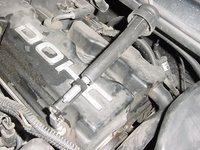 1999 Dodge Stratus,
1999 Dodge Stratus, Intermittent Stalling/No-start
I always first like to verify the complaint. In this case the car owner said the car would stall occasionally and not restart for several minutes. It seemed to make no difference if the car was at idle or at road speed. I decided to start by just letting the car run at idle in the shop while I spent some time on other cars and waited for the stall to occur. I don't start with a road test for a complaint like this because it's usually a lot easier to find the cause of a no-start than a stall. If it won't start the testing equipment for that will be right there in the shop. If it stalls and won't start on the road I'm not likely to have the proper tools with me for finding the problem.
After nearly an hour I heard the car stop running. I noted that the engine died suddenly. When you are the diagnostic detective every clue is important. It isn't likely to be a fuel pressure or fuel/air mixture problem if it dies quickly with no warning. Fuel pressure or control problems that cause a stall at idle will usually give you a warning. What I mean is that you will notice the engine begin to run poorly and then stall. Since the car owner said that the car would not immediately restart but would after some time had passed then the time to do some testing was now. I wanted to first see if secondary ignition spark was present since it seemed most likely to not be a fuel problem. The Stratus 2.4 designers were kind enough to make it easy to access the ignition system, the fuel injectors and the fuel pressure port. The car does have a coil and does have plug wires. It is very easy to place a simple spark tester in the end of a plug wire to watch for spark. The trouble here was that as soon as I hit start I not only had spark but the car started. The difference between a no-start diagnosis and a stall diagnosis is time to test. With an intermittent stall it only takes a signal or fault to occur for less than a second to kill the engine. A no-start problem occurs for the entire time the car won't start. I decided to let the car stall yet again and hoped the no-start would appear as well.
In the mean time a scan tool peek couldn't hurt. I didn't immediately go to a scan approach because no MIL was on and no-start testing should be more relevant once it won't start. When you are looking for scan data in any OBDII equipped automobile there are two systems to consider. The OBDII system and the OEM system share some information and hold some exclusive to themselves. I always look at both systems when looking for codes or stored data.
Just to mention on this particular topic, there are two ways to access OBDII data on most full-function scan tools. Generically/Globally the scan tool will access and give you the data for that. However, if you access the OBDII system from a scan tool that allows the oem data entered then you usually will get more help from the scan tool. I'll explain. Here is an example, suppose you are wondering the conditions that must be met for a car to satisfy a monitor test for an O2 sensor heater. If you have a full-function scan tool but are entered under generic/global testing you won't get a clue from the scan tool on the criteria to meet the test. The tests were mandated but the means to test were left to the manufacturer. If you have a full function scan tool and enter OBDII after the tool knows the car data then the scan tool software should help by defining the conditions the manufacterer designed into the programming for the monitor.
Once I get the OBDII data scans done I like to look at the OEM stuff. Now when you have a full function scan tool and it is compatible with the car you are testing then you get a lot of options for further information. Most cars these days have more than one computer and it's never a bad thing to look for the information that each one has stored.
Watch for part 2,


